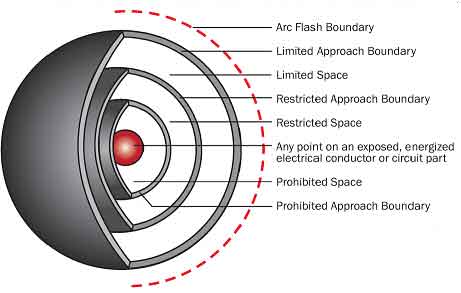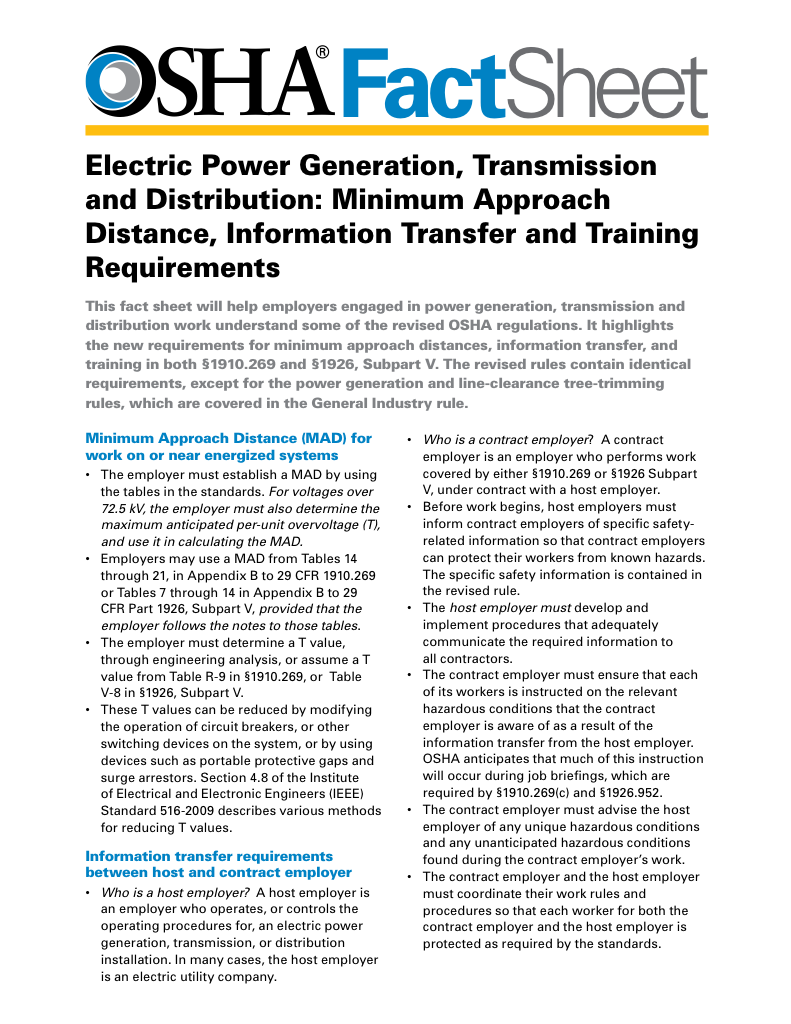What's the Arc Flash Boundary for 8 cal/cm²?
By R.W. Hurst, Editor

CSA Z462 Arc Flash Training - Electrical Safety Essentials
Our customized live online or in‑person group training can be delivered to your staff at your location.

- Live Online
- 6 hours Instructor-led
- Group Training Available
Download Our OSHA 3873 Fact Sheet – Minimum Approach Distance and Training Requirements

- Calculate MAD using voltage and overvoltage values
- Ensure proper communication between host and contract employers
- Meet OSHA training requirements for qualified electrical workers
What is the arc flash boundary for 8 cal cm2? Per NFPA 70E and IEEE 1584, it is the distance where incident energy equals 1.2 cal/cm2, varying with working distance, fault current, and clearing time.
What Is the Arc Flash Boundary for 8 cal cm2?
Boundary is at 1.2 cal/cm2; 8 cal/cm2 is PPE Cat 2. Calculate per NFPA 70E/IEEE 1584
✅ Boundary is defined at 1.2 cal/cm2 incident energy
✅ Depends on working distance, fault current, clearing time
✅ Use NFPA 70E/IEEE 1584 arc flash calculation methods
What's the arc flash boundary for 8 cal/cm², and why does it matter for electrical safety compliance? This energy level represents a critical threshold for determining safe approach distances in industrial and utility environments. If you're wondering what’s the arc flash boundary for 8 cal cm2, this guide explains the factors involved in calculating safe distances. The arc flash boundary (AFB) defines the minimum distance at which a person must wear appropriate personal protective equipment (PPE) to prevent second-degree burns from an arc event. Understanding how this boundary is calculated—based on incident energy, system voltage, and fault clearing time—is essential for ensuring workplace safety and meeting NFPA 70E standards. For a concise primer on the math and assumptions, see the understanding arc flash calculations resource for additional context.
Request a Free Training Quotation
The arc flash boundary is the minimum distance from an electrical source where a worker could be exposed to a potential hazard that could cause second-degree burns. For an incident energy of 8 cal/cm², the boundary is calculated based on the distance at which the incident energy is reduced to 1.2 cal/cm²—the threshold for the onset of a second-degree burn. Generally, the boundary is determined through calculations outlined in NFPA 70E, which defines safe working practices for electrical safety. For general information on boundaries, refer to our Arc Flash Boundary page. To see how distance varies with inputs, consult the arc flash boundary calculation guide for step-by-step examples.
Test Your Knowledge About Arc Flash!
Think you know Arc Flash? Take our quick, interactive quiz and test your knowledge in minutes.
- Instantly see your results and score
- Identify strengths and areas for improvement
- Challenge yourself on real-world electrical topics
For 8 cal/cm², the specific distance of the AFB depends on various factors such as system voltage, available fault current, and the clearing time of protective devices. The boundary serves as a guide to determine when workers need to don proper PPE.
For alignment with shock protection zones, review how arc flash and electric shock protection boundaries are determined across typical equipment classes.
How is the Arc Flash Boundary Calculated for Different Levels of Incident Energy, Including 8 cal/cm²?
The AFB calculation involves determining the distance at which the incident energy reduces to a safe level of 1.2 cal/cm². For an energy level of 8 cal/cm², electrical engineers typically use software or formulas from NFPA 70E to account for system characteristics, such as voltage and fault current, and calculate the appropriate boundary. Engineers often reference the arc flash boundary table by incident energy to cross-check results and PPE selections.
The calculation methods also consider the duration of the fault and the clearing time of protective devices. While 8 cal/cm² represents a moderate risk of burn injury, the boundary is larger than for lower energy levels, meaning workers need to maintain a greater distance from the source or wear enhanced protective gear within the boundary. When scoping tasks and approach distances, a quick scan of the arc flash boundary chart can help communicate risk levels to crews.
Estimated Boundary Distance for 8 cal/cm²
While exact distances depend on the equipment type and fault conditions, here’s a typical example based on NFPA 70E calculations: For typical ranges and definitions, the Arc Flash Boundary overview provides a helpful frame of reference for planning work.
What PPE Should Be Worn Within the Arc Flash Boundary for 8 cal/cm²?
Within the 8 cal/cm² boundary, specific personal protective equipment (PPE) is required to prevent severe burns and other injuries. The most essential component is the arc-rated clothing with an arc rating of 8 cal/cm² or greater. This often includes a long-sleeved shirt and pants designed to withstand the energy from the arc.
However, additional PPE is often required to ensure complete protection depending on the situation. This includes face shields, gloves, and potentially a flash suit hood or full-body flash suit for higher incident energy levels. NFPA 70E mandates that the PPE required within the boundary for 8 cal/cm² should protect against the onset of second-degree burns.
The typical PPE category for 8 cal/cm² is PPE Category 2, which requires a minimum arc rating of 8 cal/cm² for clothing. If the incident energy were higher, more robust PPE, such as a suit with a minimum arc rating of 40 cal/cm², might be necessary.
How Does the Arc Flash Boundary for 8 cal/cm² Compare to Other Energy Levels?
The boundary's size increases with higher incident energy levels. For 8 cal/cm², the boundary is moderate in size compared to lower energy levels, such as 1.2 or 4 cal/cm², which have smaller boundaries. Lighter PPE, such as a long-sleeved shirt and pants, might be sufficient at lower levels.
On the other hand, higher incident energies, such as a minimum arc rating 40 cal/cm² or above, require a much larger boundary and heavier PPE, including flash suit hoods and full-body suits. The boundary extends further from the source to protect workers from life-threatening burns and injuries for such high energy exposures.
What Factors Influence the Size of the Arc Flash Boundary for 8 cal/cm²?
Several factors influence the size of the arc flash boundary for 8 cal/cm²:
- System Voltage: The higher the system voltage, the more intense the incident energy can lead to a larger boundary.
- Fault Current: The magnitude of available fault current plays a significant role in determining the incident energy. Higher fault currents result in more intense energy releases, requiring a larger boundary.
- Clearing Time: The time it takes for protective devices to clear a fault also affects the boundary size. Faster clearing times can limit the energy released during the arc, reducing the boundary distance.
- Equipment Configuration: The type and configuration of electrical equipment, such as transformers and switchgear, impact the potential hazard, altering the boundary size.
- Work Environment: Factors like humidity, dust, or equipment conditions can influence the likelihood and severity of an incident, thereby affecting the boundary.
The Importance of a Safety Program
Implementing an effective electrical safety program is critical for mitigating hazards. A comprehensive program includes regular training on identifying potential risks, selecting appropriate PPE, and understanding the AFB for various incident energy levels. Workers should be trained in wearing the correct PPE, such as an arc-rated shirt and pants, face shields, gloves, and flash suit hoods when required, and they should be educated about the potential for burn injury and second-degree burns within the boundary.
FREE EF Electrical Training Catalog
Download our FREE Electrical Training Catalog and explore a full range of expert-led electrical training courses.

- Live online and in-person courses available
- Real-time instruction with Q&A from industry experts
- Flexible scheduling for your convenience
Clear field controls are essential, and this includes knowing how to mark off arc flash boundaries with appropriate labeling and barriers.
In conclusion, understanding the arc flash boundary for 8 cal/cm² is a crucial aspect of electrical safety. By calculating the boundary, wearing the appropriate PPE, and considering the influencing factors, workers can protect themselves from the dangers of potential hazards. A well-developed safety program following NFPA 70E guidelines helps ensure the protection of personnel and minimizes the risk of injury in hazardous environments.
Related Pages
Arc Flash Boundary Table By Incident Energy







